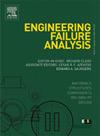Fracture mechanism analysis and life-prolonging investigation of butt weld for ladle crane
IF 4.4
2区 工程技术
Q1 ENGINEERING, MECHANICAL
引用次数: 0
Abstract
The butt weld between the T-shaped steel and the main web of ladle crane is a crucial weld to bear the lifting load. Since it is mainly considered to be subjected to compressive stress, this weld is generally not regarded as the key area of fatigue assessment. An obvious crack was found in the butt weld of an in-service ladle crane during a routine inspection. In this paper, the cracking mechanism and life-prolonging scheme were studied by means of field tests and numerical analysis. Firstly, the stress history signal according to the cracked area were acquired with several working cycles. It was concluded that the unconventionally imagined tensile and compressive stress are generated during the running process of the crane, which further led to several high-level stress cycles in a typical working cycle. A Finite Element Model (FEM) of the bridge containing a fine solid mesh of the studied weld was established by using sub-model technology. Combined with the rain flow counting results of the measured stresses and the Equivalent Structural Stress (ESS) solving technique based on the FEM, the ESS spectrum of the cracked area was proposed. The fatigue life of the cracked local area is analyzed based on the stress spectrum and the failure mechanism of the butt weld is revealed. A life-prolonging scheme for the cracked local structure was proposed and the fatigue life of the butt-weld area after reinforcement is predicted by using the ESS spectrum, which verifies the effectiveness of reinforcement. Up to now, the ladle crane has been operating normally for nearly 4 years, no new cracks have appeared in the originally cracked are, providing the effectiveness of the life-prolonging scheme.
求助全文
约1分钟内获得全文
求助全文
来源期刊

Engineering Failure Analysis
工程技术-材料科学:表征与测试
CiteScore
7.70
自引率
20.00%
发文量
956
审稿时长
47 days
期刊介绍:
Engineering Failure Analysis publishes research papers describing the analysis of engineering failures and related studies.
Papers relating to the structure, properties and behaviour of engineering materials are encouraged, particularly those which also involve the detailed application of materials parameters to problems in engineering structures, components and design. In addition to the area of materials engineering, the interacting fields of mechanical, manufacturing, aeronautical, civil, chemical, corrosion and design engineering are considered relevant. Activity should be directed at analysing engineering failures and carrying out research to help reduce the incidences of failures and to extend the operating horizons of engineering materials.
Emphasis is placed on the mechanical properties of materials and their behaviour when influenced by structure, process and environment. Metallic, polymeric, ceramic and natural materials are all included and the application of these materials to real engineering situations should be emphasised. The use of a case-study based approach is also encouraged.
Engineering Failure Analysis provides essential reference material and critical feedback into the design process thereby contributing to the prevention of engineering failures in the future. All submissions will be subject to peer review from leading experts in the field.
 求助内容:
求助内容: 应助结果提醒方式:
应助结果提醒方式:


